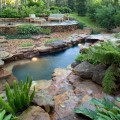Moss Gardens
Moss gardens are the easiest of gardens to grow and maintain. Moss is a primitive form of plant life that can thrive in conditions that kill other plants. The one thing that moss must have is a high level of moisture. Since we live in one of the most humid climates in America, we Houstonians have an ideal environment for the cultivation of aesthetically pleasing plantings of moss.
One of the reasons moss is so hardy is that it does not need a root system to survive. Moss absorbs its nutrients through tiny stem-like structures called rhizoids. Depending on the species of moss you plant, these rhizoids will fan out under the ground, grow along the surface of rocks, or embed themselves in decaying wood. They absorb water and nutrients directly from their surroundings.
Because of this, a moss garden can be planted anywhere in your yard provided that the conditions of that location supports the species of moss you plant. There are thousands of different species, and all thrive on high concentrations of moisture. Generally speaking, most prefer shady areas as well, although there are some species that prefer sunlight.
The aesthetic improvement that such a garden offers can exceed that of lawn grass. Moss creates the equivalent of green, natural carpet wherever it grows thick. Such a carpeted look can add drama and interest to your yard in a way that little else can. This diversity makes it possible for any homeowner in any part of Houston to successfully grow some kind of moss regardless of the sunlight conditions, tree growth, or size of the yard.
In Memorial and River Oaks homes, moss landscapes are typically planted underneath large trees in places that virtually never see sunlight. Such areas tend to be barren patches of unattractive gumbo dirt that nothing can take root in. While a shade garden may be an option for such a place, finding shade resistant flowering plants that can thrive in such inhospitable conditions can be very expensive.
A more reasonable, cost effective, and in many cases, more beautiful alternative is a moss garden that covers the entire area beneath your oaks and pines with a beautiful carpet of living green. Provided you avoid using any chemicals in these areas that could damage the moss, you can count on it maintaining its texture and color year round with absolutely no maintenance needed on your part.
In other parts of the city, lots can be very small in comparison to those of Houston’s wealthiest neighborhoods. Many areas of town, too, have large concentrations of townhomes and patio homes. People living in these areas often assume incorrectly that landscaping is not for them because they have so little yard to actually landscape. In reality, a great deal can be done for even the smallest property when professional designers take the helm.
Moss gardens can be grown in low-level planters to add a velvet-like touch of green to any patio. They can also be used to line the sides of a townhome and accentuate its boundaries. Some townhomes, due to their architecture, block the sunlight in the back yard, making it almost impossible to plant traditional flower beds and gardens.
Again, finding a species of shade resistant moss is no big challenge, and the rewards of a little creative planting cannot be understated when you look out the window of one of these homes and see a world of thriving green springing up in a place that everyone would have otherwise have written off as completely dead long ago.
Finally, keep in mind that the existence of sunlight-friendly moss also makes it possible for suburban homeowners with very large backyards to add some biodiversity to an otherwise unbroken field of lawn grass. Moss gardens here can be planted in all manner of interesting geometric designs. In some cases, combining rocks and moss to make a three dimensional garden of green can also add vertical impact to the terrain.

